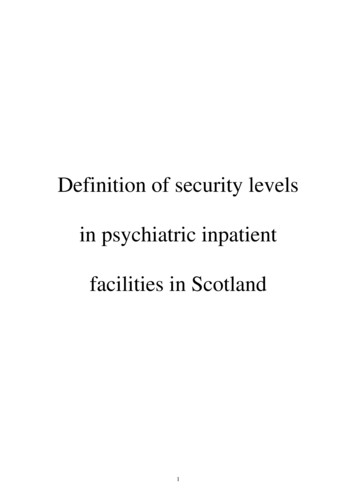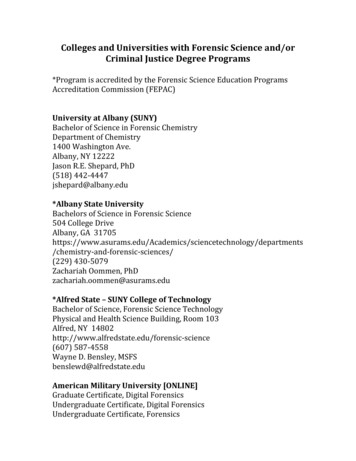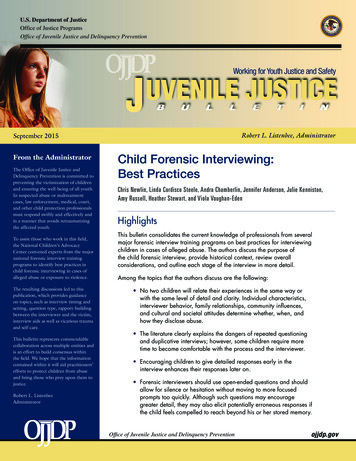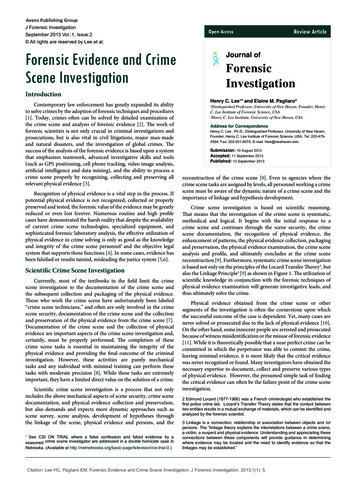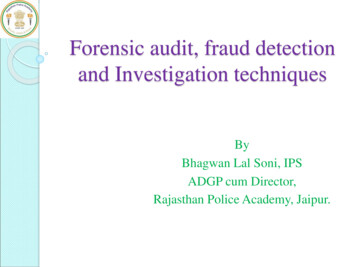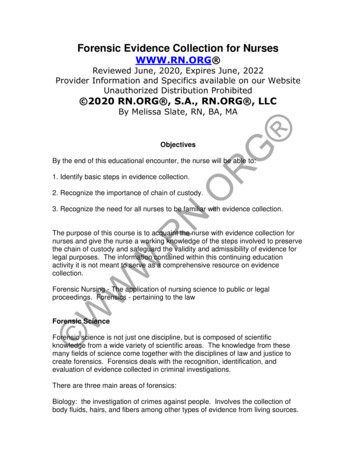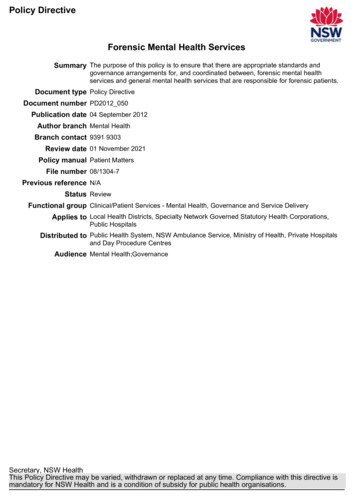
Transcription
Fourth EditionFORENSICSCIENCERICHARD SAFERSTEIN,From theCRIME SCENEto theCRIME LABPh.D.Forensic Science Consultant, Mt. Laurel, New Jersey330 Hudson Street, NY NY 10013A01 SAFE3722 04 SE FM.indd 112/2/17 5:35 AM
Vice President, Portfolio Management: Andrew GilfillanPortfolio Manager: Gary BauerEditorial Assistant: Lynda CramerSenior Vice President, Marketing: David GesellField Marketing Manager: Bob NisbettProduct Marketing Manager: Heather TaylorSenior Marketing Coordinator: Les RobertsDirector, Digital Studio and Content Production: Brian HylandManaging Producer: Cynthia ZonneveldManager, Rights Management: Johanna BurkeOperations Specialist: Deidra SmithCreative Digital Lead: Mary SienerManaging Producer, Digital Studio: Autumn BensonContent Producer, Digital Studio: Maura BarclayFull-Service Management and Composition:Integra Software Services, Ltd.Full-Service Project Manager: Ranjith RajaramCover Design: Studio MontageCover Image: MedicalRF.com/Getty Image; zffoto/ShutterstockPrinter/Binder: LSC Communications, Inc.Cover Printer: Phoenix Color/HagerstownText Font: Versailles LT Com 10/12Acknowledgments of third-party content appear on the appropriate page within the text.Copyright 2019, 2016 by Pearson Education, Inc. or its affiliates. All rights reserved. Manufactured in the United States ofAmerica. This publication is protected by copyright, and permission should be obtained from the publisher prior to any prohibitedreproduction, storage in a retrieval system, or transmission in any form or by any means, electronic, mechanical, photocopying,recording, or otherwise. For information regarding permissions, request forms, and the appropriate contacts within the PearsonEducation Global Rights and Permissions department, please visit www.pearsoned.com/permissions/.Library of Congress Cataloging-in-Publication DataNames: Saferstein, Richard, 1941- author.Title: Forensic science : from the crime scene to the crime lab / RichardSaferstein, Ph.D., Forensic Science Consultant, Mt. Laurel, New Jersey.Description: Fourth Edition. Hoboken : Pearson, [2018] Revised edition ofthe author’s Forensic science, 2016.Identifiers: LCCN 2017038221 ISBN 9780134803722 ISBN 0134803728Subjects: LCSH: Criminal investigation. Crime scene searches. Forensicsciences. Evidence, Criminal.Classification: LCC HV8073 .S214 2018 DDC 363.25—dc23LC record available at https://lccn.loc.gov/2017038221117Student Edition:ISBN 10:0-13-480372-8ISBN 13: 978-0-13-480372-2Student Value Edition:ISBN 10:0-13-480611-5ISBN 13: 978-0-13-480611-2A01 SAFE3722 04 SE FM.indd 212/2/17 5:35 AM
For Mom (1917–2010)and toZave and GabrielleA01 SAFE3722 04 SE FM.indd 312/2/17 5:35 AM
A01 SAFE3722 04 SE FM.indd 412/2/17 5:35 AM
BRIEF Securing and Searching the Crime Scene35Recording the Crime Scene 53Collection of Crime-Scene EvidencePhysical Evidence86111Death Investigation 131Crime-Scene Reconstruction162Forensic Biometrics: Fingerprints and Facial RecognitionFirearms, Tool Marks, and Other ImpressionsBloodstain Pattern AnalysisDrugs175207246269Forensic Toxicology309Trace Evidence I: Hairs and Fibers339Trace Evidence II: Paint, Glass, and SoilBiological Stain Analysis: DNA365390Forensic Aspects of Fire and Explosion InvestigationDocument ExaminationComputer Forensics435467487Digital and Multimedia Forensics: Cell phones, Video, and Audio520vA01 SAFE3722 04 SE FM.indd 512/2/17 5:35 AM
A01 SAFE3722 04 SE FM.indd 612/2/17 5:35 AM
CRIME-SCENE RECONSTRUCTIONviiCONTENTSPreface xviiAbout the Author1xxiIntroduction 1Definition and Scope of Forensic Science2History and Development of Forensic Science4History and Organization of Crime Laboratories10Other Forensic Science Services 17Functions of the Forensic ScientistChapter ReviewKey Terms2930Review QuestionsApplication23031Critical ThinkingEndnotes203434S ecuring and Searchingthe Crime Scene 35Securing the Crime Scene 36Surveying the Crime Scene 37Searching the Crime Scene 39Chapter ReviewKey Terms4343Review QuestionsApplication44Critical ThinkingCase Analysis434545Case Reading: The Enrique Camarena Case: A Forensic Nightmare46viiA01 SAFE3722 04 SE FM.indd 712/2/17 5:35 AM
viiiCONTENTS3 Recording the Crime SceneNotes5354Photography 55Crime-Scene Photography63Crime-Scene Images 65Video Documentation 73Sketching the Crime Scene 74Chapter Review 82Key Terms83Review QuestionsApplication84Critical Thinking48385Collection of Crime-Scene Evidence86Common Types of Physical Evidence 87Evidence-Collection Tools 88Procedures for Collecting and Packaging Physical Evidence90Ensuring Crime-Scene Safety 100Legal Considerations at the Crime Scene106Chapter Review 108Key Terms108Review QuestionsApplication110Critical ThinkingEndnotes5109110110Physical Evidence111Examination of Physical Evidence 112Significance of Physical Evidence 116Forensic Databases 120Forensic Palynology: Pollen and Spores as Evidence126Chapter Review 129Key Terms129A01 SAFE3722 04 SE FM.indd 812/2/17 5:35 AM
CONTENTSReview QuestionsApplication129130Critical ThinkingEndnotesix1301306 Death InvestigationRole of the Forensic Pathologist131132Cause of Death 133The Autopsy137Manner of Death 141Estimating Time of Death 144Role of the Forensic AnthropologistRole of the Forensic EntomologistChapter ReviewKey Terms154157158Review QuestionsApplication147158160Critical Thinking1617 Crime-Scene Reconstruction162Fundamentals of Crime-Scene Reconstruction 163Requirements for Crime-Scene Reconstruction 166Assessment of Evidence and Information to Form TheoriesChapter ReviewKey Terms173174Critical ThinkingA01 SAFE3722 04 SE FM.indd 9172173Review QuestionsApplication16917412/2/17 5:35 AM
x8CONTENTSF orensic Biometrics: Fingerprints and FacialRecognition 175What Is Biometrics?176Fundamental Principles of FingerprintsClassification of Fingerprints177183Automated Fingerprint Identification SystemsMethods of Detecting FingerprintsPreservation of Developed Prints184187194Digital Imaging for Fingerprint Enhancement195Chapter Review 202Key Terms203Review QuestionsApplication204Critical ThinkingEndnotes203206206irearms, Tool Marks, and9 FOtherImpressions 207Classifying Firearms and Comparing Bullets and CartridgesAutomated Firearms Search Systems208217Gunpowder and Primer Residues 221Serial Number Restoration228Collection and Preservation of Firearms EvidenceTool Marks231232Other Impressions235Chapter Review 242Key Terms243Review QuestionsApplication244Critical ThinkingEndnotes243245245A01 SAFE3722 04 SE FM.indd 1012/2/17 5:35 AM
CONTENTS10Bloodstain Pattern AnalysisGeneral Features of Bloodstain FormationImpact Bloodstain Spatter PatternsMore Bloodstain Spatter PatternsOther Bloodstain Patterns247253257263Bloodstain Pattern Analysis: Proceed with CautionKey Terms266266267Critical ThinkingEndnotes264265Review QuestionsApplication246249Documenting Bloodstain Pattern EvidenceChapter Reviewxi26826811 Drugs269Drug Dependence 270Types of Drugs273Drug Control Laws286Collection and Preservation of Drug Evidence287Forensic Drug Analysis 287Chapter ReviewKey Terms305Review QuestionsApplication305306Critical ThinkingEndnotes30430830812 Forensic ToxicologyRole of Forensic Toxicology309310Toxicology of Alcohol 310Testing for Intoxication312Analysis of Blood for Alcohol320Alcohol and the Law 321A01 SAFE3722 04 SE FM.indd 1112/2/17 5:35 AM
xiiCONTENTSRole of the ToxicologistDrug Recognition Experts324331Chapter Review 335Key Terms336Review QuestionsApplication336337Critical Thinking338Endnotes33813Trace Evidence I: Hairs and Fibers339Morphology of Hair 340Forensic Examination of Hair 345Collection and Preservation of Hair EvidenceTypes of Fibers349350Forensic Examination of Fibers354Collection and Preservation of Fiber Evidence358Chapter Review 360Key Terms361Review QuestionsApplication361362Critical Thinking364Endnotes36414Trace Evidence II: Paint, Glass, and SoilForensic Examination of Paint365366Forensic Analysis of Glass 372Forensic Analysis of Soil 382Chapter Review 386Key Terms387Review QuestionsApplication388Critical ThinkingEndnotes387389389A01 SAFE3722 04 SE FM.indd 1212/2/17 5:35 AM
CONTENTS15 Biological Stain Analysis: DNAThe Nature of Bloodxiii390391Immunoassay Techniques 394Forensic Characterization of BloodstainsForensic Characterization of Semen399Collection of Sexual Assault EvidenceUnderstanding DNA395403406Polymerase Chain Reaction (PCR) 410DNA Typing with Short Tandem RepeatsMitochondrial DNA412418Combined DNA Index System (CODIS)420Collection and Preservation of Biological Evidence for DNA AnalysisChapter ReviewKey Terms427429Review QuestionsApplication429431Critical ThinkingEndnotes422432434orensic Aspects of Fire and Explosion16 FInvestigation435Forensic Investigation of ArsonChemistry of Fire436436Searching the Fire Scene442Collection and Preservation of Arson Evidence445Analysis of Flammable Residues 447Explosions and Explosives 451Collection and Analysis of Evidence of ExplosivesChapter ReviewKey TermsA01 SAFE3722 04 SE FM.indd 13464465Critical ThinkingEndnotes462463Review QuestionsApplication45846546612/2/17 5:35 AM
xivCONTENTS17Document Examination 467Document Examiner 468Handwriting Comparisons 468Typescript Comparisons475Alterations, Erasures, and ObliterationsOther Document Problems477481Chapter Review 484Key Terms485Review QuestionsApplication485486Critical Thinking486Endnotes48618 Computer Forensics487Andrew W. DonofrioFrom Input to Output: How Does the Computer Work?488Storing and Retrieving Data 493Processing the Electronic Crime SceneAnalysis of Electronic Data495500Forensic Analysis of Internet Data 507Forensic Investigation of Internet CommunicationsMobile Forensics510514Chapter Review 516Key Terms517Review QuestionsApplication518Critical ThinkingEndnotes517519519A01 SAFE3722 04 SE FM.indd 1412/2/17 5:35 AM
CONTENTS19xv igital and Multimedia Forensics:DCell phones, Video, and Audio 520Peter StephensonThe Mobile Device Neighborhood 521Forensic Challenges 523Extracting Useful Data 525Mobile Device Architecture526Analyzing Mobile Devices 528Hybrid Crime Assessment 532Chapter SummaryKey Terms534535Review QuestionsApplication535536Critical Thinking539Further ReferencesEndnotes539539Appendix540Appendix IHandbook of Forensic Services—FBI541Appendix IIInstructions for Collecting Gunshot Residue (GSR) 542Appendix III Chemical Formulas for Latent FingerprintDevelopment544Appendix IV Chemical Formulas for Development of FootwearImpressions in Blood 548Answers to End-of-Chapter QuestionsGlossaryIndex551566573A01 SAFE3722 04 SE FM.indd 1512/2/17 5:35 AM
A01 SAFE3722 04 SE FM.indd 1612/2/17 5:35 AM
CRIME-SCENE RECONSTRUCTIONxviiPREFACENew to This Edition New! Numerous case files have been added to select chapters to illustrate how forensic technology has been applied to solving crimes of notoriety. Chapter 3, “Recording the Crime Scene,” has been updated to include a discussion ofbody worn cameras and their role in crime scene documentation. Chapter 8, “Forensic Biometrics: Fingerprints and Facial Recognition,” is a new chapter focusing on the application of fingerprint, iris, and facial biometrics used to createbiometric databases. Chapter 5, “Physical Evidence,” has been updated to introduce the reader to the newFBI Next Generation Identification system (NGI), created as a repository for biometricinformation. Chapter 15, “DNA: The Indispensable Tool,” has been revised to address updates tothe Combined DNA Indexing System to reflect newly implemented technologies anddatabase expansion. Chapter 16, “Forensic Aspects of Fire and Explosion Investigation,” has been expanded to cover the discussion of the deviation of fire from normal behavior and how itimpacts on burn pattern interpretations at fire scenes. Information throughout the text has been updated and many new figures have beenadded to illustrate concepts discussed in the chapters.Purpose of This BookWhen one sets out to write a textbook on the current state of forensic science, the firstthings that come to mind are all the sophisticated high-tech devices at the disposal ofthe forensic analyst. A textbook devoted to this topic can quickly overwhelm the studentwho has little or no prior coursework in the basic sciences and who is averse to correctingthis deficiency. Although a study of forensic science must include coverage of some basicscientific principles, the coverage must be presented in a fashion that will not “turn off”the student. Like the third edition, Forensic Science: From the Crime Scene to theCrime Lab, Fourth Edition, is designed to accomplish this objective by presenting thescience of forensics in a straightforward and student-friendly format.Topics are arranged to integrate scientific methodology with actual forensic applications. Discussions of the scientific topics focus on state-of-the-art technology without delving into extraneous theories that may bore or overwhelm the nonsciencestudent. Only the most relevant scientific and technological concepts are presented.A major portion of the text centers on the role of the crime-scene investigator inxviiA01 SAFE3722 04 SE FM.indd 1712/2/17 5:35 AM
xviiiPREFACEpreserving, recording, and collecting physical evidence at the crime scene. Chapter 3,describing the application of photography to the crime scene, has been updated tointroduce the use of the body worn camera at crime scenes. One key concern duringthe collection of a DNA-containing specimen is contamination. Appropriate insightshave been added to the text for minimizing this type of occurrence during the collection and packaging of biological evidence. The fourth edition also includes a newchapter (Chapter 8), “Forensic Biometrics and Facial Recognition.”Descriptions and pertinent forensic facts about cases of notoriety are provided for thereader. The intent is to demonstrate to the reader actual applications of forensic science toreal-life case investigations.The reader is offered the option of delving into the more difficult technical aspects ofthe subject by reading the Closer Analysis features. This option can be bypassed withoutdetracting from a basic comprehension of the subject of forensic science.Within and at the end of each chapter, the reader will encounter Quick Reviews anda Chapter Review that recap all of the major points of the chapter. The end-of-chapterSummary is followed by Review Questions, as well as Application and Critical Thinkingexercises designed to enhance the reader’s learning experience.AcknowledgmentsI would like to thank Tiffany Roy for her assistance in the preparation of the newest editionof this book. Tiffany is a Forensic DNA expert living and working in South Florida, who hasworked in both public and private DNA laboratories in the United States. As an undergraduate professor and a licensed attorney, her unique perspective influenced a numberof chapter updates as well as case file additions.I am most appreciative of the contribution that retired Lieutenant Andrew (Drew)Donofrio of New Jersey’s Bergen County Prosecutor’s Office and now a leading privatecomputer forensic examiner made to this new edition. I was fortunate to find in Drew acontributor who not only possesses extraordinary skill, knowledge, and hands-on experience with computer forensics, but was able to combine those attributes with sophisticatedcommunication skills. Likewise, I was fortunate to have Dr. Peter Stephenson contributeto this book on the subject of mobile forensics. He brings skills as a cybercriminologist,author, and educator in digital forensics.Likewise, I was very fortunate to engage the services of Michelle Tetrault as my researchassistant during the preparation of the first and second editions of Forensic Science: Fromthe Crime Scene to the Crime Lab. Michelle is an extraordinarily gifted student out of CedarCrest College in Allentown, Pennsylvania, and George Washington University. She wasinstrumental in helping me write and organize a number of the chapters in this text. Herskills and tenacity in carrying out her tasks are acknowledged and greatly appreciated.A01 SAFE3722 04 SE FM.indd 1812/2/17 5:35 AM
PREFACExixLikewise, Jacque Campbell, a graduate student in forensic science from Arcadia University,provided valuable assistance in preparing chapter updates and examination questions forthe new edition.Many people provided assistance and advice in the preparation of this book.Many faculty members, colleagues, and friends have read and commented on variousportions of the text. I would like to acknowledge the contributions of Anita Wonder,Robert J. Phillips, Norman H. Reeves, Jeffrey C. Kercheval, Robert Thompson, RogerEly, Jose R. Almirall, Michael Malone, Ronald Welsh, Joshua Wilborne, David Pauly,Jan Johnson, Natalie Borgan, Dr. Barbara Needell, Robin D. Williams, Peter Diaczuk,Ken Radwill, Randi Dubnick, and Jacqueline E. Joseph. I’m appreciative of the contributions, reviews, and comments that Dr. Claus Speth, Dr. Mark Taff, Dr. ElizabethLaposata, Thomas P. Mauriello, and Michelle D. Miranda provided during the preparation of Chapter 6, “Death Investigation.”Finally, I thank the following reviewers of this edition: Vicki Harder, Western NewMexico University, Becky Merrow, White Mountains Community College Jerry Stinson II,Southwest Virginia Community College, Kelly Treece, Glenville State College.Instructor SupplementsInstructor’s Manual with Test Bank includes content outlines for classroom discussion, teaching suggestions, and answers to selected end-of-chapter questions from thetext. This also contains a Word document version of the test bank.TestGen. This computerized test generation system gives you maximum flexibility in creating and administering tests on paper, electronically, or online. It providesstate-of-the-art features for viewing and editing test bank questions, dragging a selected question into a test you are creating, and printing sleek, formatted tests in avariety of layouts. Select test items from test banks included with TestGen for quicktest creation, or write your own questions from scratch. TestGen’s random generatorprovides the option to display different text or calculated number values each timequestions are used.PowerPoint Presentations. Our presentations offer clear, straightforward outlinesand notes to use for class lectures or study materials. Photos, illustrations, charts, andtables from the book are included in the presentations when applicable.To access supplementary materials online, instructors need to request an instructoraccess code. Go to www.pearsonhighered.com/irc, where you can register for aninstructor access code. Within 48 hours after registering, you will receive a confirming email, including an instructor access code. Once you have received your code, go to the siteand log on for full instructions on downloading the materials you wish to use.A01 SAFE3722 04 SE FM.indd 1912/2/17 5:35 AM
xxPREFACEREVEL for Forensic Science: From the CrimeScene to the Crime Lab, Fourth Edition byRichard SafersteinDesigned for the Way Today’s Criminal Justice Students Read,Think, and LearnREVEL offers an immersive learning experience that engages students deeply, while giving them the flexibility to learn their way. Media interactives and assessments integrateddirectly within the narrative enable students to delve into key concepts and reflect on theirlearning without breaking stride. REVEL seamlessly combines the full content of Pearson’s bestselling criminal justicetitles with multimedia learning tools. You assign the topics your students cover. AuthorExplanatory Videos, application exercises, and short quizzes engage students andenhance their understanding of core topics as they progress through the content. Instead of simply reading about criminal justice topics, REVEL empowers students to thinkcritically about important concepts by completing application exercises, watching Point/CounterPoint videos, and participating in shared writing (discussion board) assignments.Track Time-on-Task throughout the CourseThe Performance Dashboard allows you to see how much time the class or individual students have spent reading a section or doing an assignment, as well as points earned perassignment. This data helps correlate study time with performance and provides a windowinto where students may be having difficulty with the material.Learning Management System IntegrationPearson provides both Blackboard Learn and Canvas integration, giving institutions, instructors, and students easy access to Revel. Our Revel integration delivers streamlined access toeverything your students need for the course in the Blackboard Learn and Canvas environments.The REVEL AppThe REVEL App further empowers students to access their course materials wherever andwhenever they want. With the REVEL App, students can access REVEL directly from theirtablet or mobile device, offline and online. Reminders and notifications can be set so younever miss a deadline. Work done on the REVEL app syncs up to the browser version, ensuring that no one misses a beat. Visit www.pearsonhighered.com/revel/Alternate VersionseBooks. This text is also available in multiple eBook formats including Adobe Reader andCourseSmart. CourseSmart is an exciting new choice for students looking to save money.As an alternative to purchasing the printed textbook, students can purchase an electronicversion of the same content. With a CourseSmart eTextbook, students can search the text,make notes online, print out reading assignments that incorporate lecture notes, and bookmark important passages for later review. For more information, or to purchase a ccess tothe CourseSmart eTextbook, visit www.coursesmart.com.A01 SAFE3722 04 SE FM.indd 2012/2/17 5:35 AM
ABOUT THE AUTHORRICHARD SAFERSTEIN, Ph.D., retired in 1991 after serving for twenty-one years asthe chief forensic scientist of the New Jersey State Police Laboratory, one of the largestcrime laboratories in the United States. He currently acts as a consultant for attorneys andthe media in the area of forensic science. During the O. J. Simpson criminal trial, Dr. Safersteinprovided extensive commentary on forensic aspects of the case for the Rivera Live show, theE! television network, ABC radio, and various radio talk shows. Dr. Saferstein holds degreesfrom the City College of New York and earned his doctorate degree in chemistry in 1970from the City University of New York. From 1972 to 1991, he taught an introductory forensicscience course in the criminal justice programs at the College of New Jersey and OceanCounty College. These teaching experiences played an influential role in Dr. Saferstein’s authorship in 1977 of the widely used introductory textbook Criminalistics: An Introduction toForensic Science, currently in its twelfth edition. Dr. Saferstein’s basic philosophy in writingForensic Science: From the Crime Scene to the Crime Lab, Fourth Edition, is to make forensicscience understandable and meaningful to the nonscience reader while giving the reader anappreciation for the scientific principles that underlie the subject.Dr. Saferstein has authored or coauthored more than forty-five technical papers covering a variety of forensic topics. He authored Basic Laboratory Exercises for ForensicScience, Second Edition (Prentice Hall, 2011), and coauthored Lab Manual for Criminalistics, Eleventh Edition (Prentice Hall, 2015). He has also edited the widely used professional reference books Forensic Science Handbook, Volume 1, Second Edition (Prentice Hall,2002), Forensic Science Handbook, Volume 2, Second Edition (Prentice Hall, 2005), andForensic Science Handbook, Volume 3, Second Edition (Prentice Hall, 2010). Dr. Safersteinis a member of the American Chemical Society, American Academy of Forensic Sciences,Canadian Society of Forensic Scientists, International Association for Identification, Northeastern Association of Forensic Scientists, and Society of Forensic Toxicologists.In 2006, Dr. Saferstein received the American Academy of Forensic Sciences Paul L. Kirkaward for distinguished service and contributions to the field of criminalistics.TIFFANY ROY, JD, Ph.D., made substantial contributions assisting Dr. Saferstein in therevision of this edition of the textbook, the supplements that accompany the textbook, andthe new Revel interactive etext. Roy is a Forensic DNA expert with over eleven years of forensic biology experience in both public and private laboratories in the United States. Sheinstructs undergraduates at Palm Beach Atlantic University in West Palm Beach, Florida;University of Maryland University College; and Southern New Hampshire University. Shecurrently acts as a consultant for attorneys and the media in the area of forensic biologythrough her firm, ForensicAid, LLC. Roy holds degrees from Syracuse University, Massachusetts School of Law, and University of Florida in the areas of Biology, Law, and ForensicScience. Her teaching, legal writing, and testimonial experience help her to take complexscientific concepts and make them easily understandable for the nonscientist.xxiA01 SAFE3722 04 SE FM.indd 2112/2/17 5:35 AM
A01 SAFE3722 04 SE FM.indd 2212/2/17 5:35 AM
Purpose of This Book When one sets out to write a textbook on the current state of forensic science, the first things that come to mind are all the sophisticated high-tech devices at the disposal of Forensic Science: From the Crime Scene to the PREFACE. chapter (Chap

